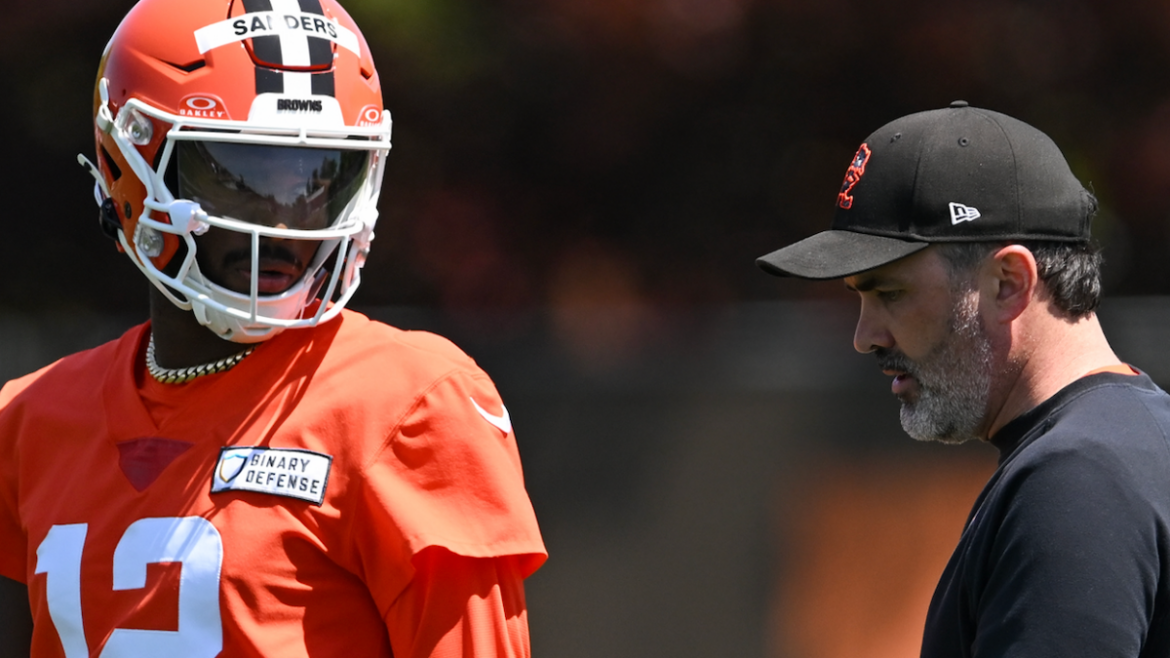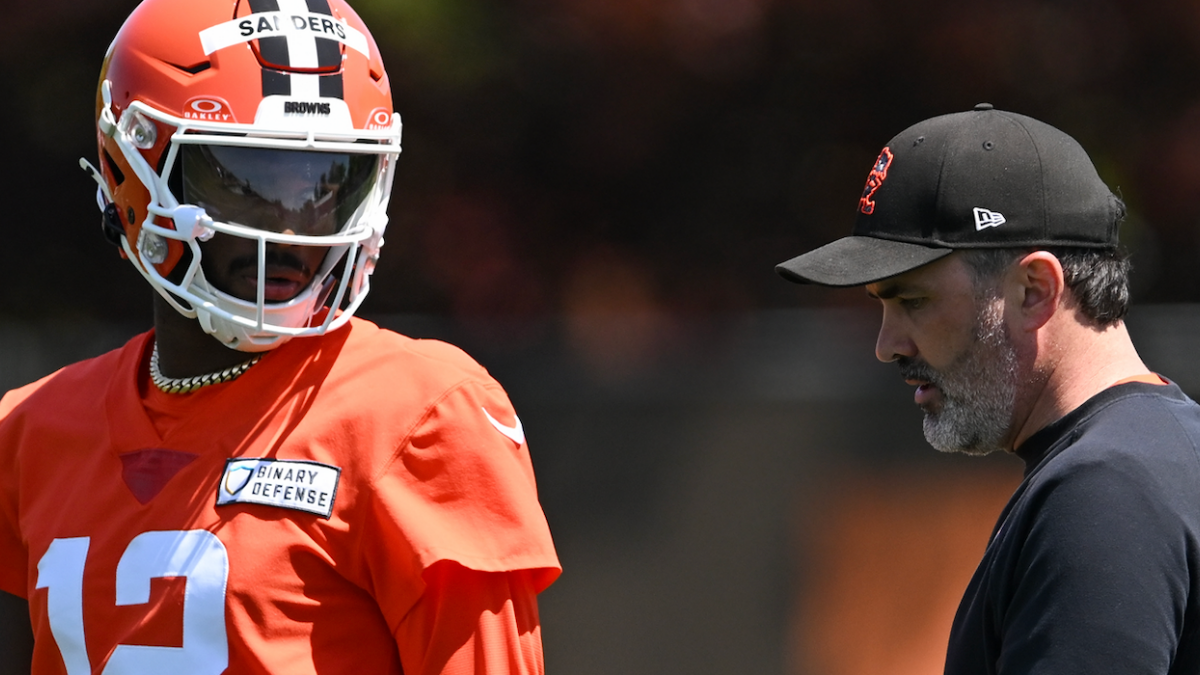The Cleveland Browns’ quarterback situation entering the 2025 NFL season has become a focal point of intrigue and intense competition, as coached by Kevin Stefanski. With a mix of veterans and rookies, the Browns face a high-stakes quarterback battle that will significantly shape their offense’s future. This report offers a comprehensive analysis of the unfolding quarterback competition, the performance and potential of rookies Shedeur Sanders and Dillon Gabriel, and the coaching perspective shaping the Browns’ approach.
A Crowded Quarterback Room: Veterans and Rookies in Competition
The Browns’ quarterback room is unusually deep for the 2025 season, featuring four quarterbacks vying for position: veterans Joe Flacco, Kenny Pickett, and recovering Deshaun Watson, joined by two rookies, Dillon Gabriel and Shedeur Sanders. This sets the stage for a “wide open” and “intense” competition, with Stefanski and the coaching staff leaving no stone unturned in their evaluation process.
Veterans bring stability and experience; however, the presence of promising rookies adds a fresh dynamic to the offseason training and team activities. The coaches are closely examining not only the physical capabilities but also intangibles such as leadership, adaptability, and work ethic. Stefanski’s remarks emphasize a holistic “all-encompassing evaluation,” signaling that the final decision will weigh practice habits, learning ability, and chemistry with the team just as heavily as game-day prowess.
Shedeur Sanders: Rapid Adaptation and Growing Momentum
Shedeur Sanders, a 2025 draft pick from the Colorado Buffaloes, has quickly attracted positive attention within the Browns organization. Coach Stefanski lauds Sanders and fellow rookie Dillon Gabriel as being “like sponges,” soaking up knowledge from coaching staff and seasoned quarterbacks including Joe Flacco, Kenny Pickett, and Deshaun Watson.
Sanders stands out for his rapid adjustment to the complexities of the NFL game, a fact underscored by analysts who describe his progression during Organized Team Activities (OTAs) as “elite.” Social media clips and reporters note Sanders’s precise throws and command in practice, reflecting a growing confidence and readiness that bolster his case.
Moreover, Sanders himself describes the quarterback room competition as “lit” and “fun,” highlighting a positive team culture despite fierce internal rivalry. His attitude suggests maturity and focus, qualities often pivotal for rookie quarterbacks adapting to the NFL’s demands.
Dillon Gabriel: Hard Work and Poised Competitor
Drafted from Oregon Ducks, Dillon Gabriel similarly impresses with a committed work ethic and growing grasp of the Browns’ offensive system. Stefanski respects Gabriel’s receptiveness to veteran perspectives, underlining adaptability as a potential differentiator in the tight race for the starting role.
Reports suggest Gabriel initially earned more reps early in rookie minicamp, a point Stefanski cautions should not be overinterpreted. Instead, the coach affirms the process is deliberately designed to give each quarterback “appropriate reps conducive to getting what he wants to see” from them, reinforcing fairness and thoroughness in evaluation.
Gabriel’s poise and leadership reportedly resonate well in the meeting rooms and practice fields alike—attributes that, combined with his consistent effort, keep him firmly in contention.
Stefanski’s Strategic Approach: Balancing Development and Competition
Kevin Stefanski, himself a two-time NFL Coach of the Year, approaches the quarterback evaluation with a strategic mindset that balances competition with development. He actively downplays outside noise and speculation, focusing instead on internal assessments and player growth.
Stefanski has not publicly indicated a frontrunner, instead emphasizing that the quarterback battle remains wide open. He acknowledges the challenge of “uneven QB reps” due to the need to optimize opportunities for each player’s evaluation. The goal is to identify who best fits the Browns’ new-look offense while fostering a positive competitive environment.
The presence of veterans like Flacco and Kenny Pickett adds layers of mentorship and competition. Their experience provides a measuring stick for rookies and a fallback option for the Browns as the quarterback competition unfolds.
Team Dynamics and Player Relationships: Collaboration Amid Competition
Importantly, both rookies, Sanders and Gabriel, speak highly of their relationship despite competing fiercely for the starting job. Their camaraderie is described as “truly cool,” with no awkwardness inside the quarterback room. This strong interpersonal dynamic likely enhances their individual development and helps maintain team cohesion.
Sanders’s candid acknowledgment of a vibrant, enjoyable quarterback room atmosphere suggests mental resilience and emotional intelligence, traits critical during high-pressure evaluations.
Challenges and Questions Ahead
Despite the positives, questions linger about the Browns’ decision-making:
– Who will ultimately secure the starting quarterback position? The competition involves multiple qualified candidates, and Stefanski’s careful, all-encompassing approach means the decision may come late into training camp or preseason.
– How will the coaching staff integrate a rookie starter into an offense undergoing changes? Coordinators and players highlight a reshaped offensive unit for 2025, underlining the importance of quarterback adaptability.
– What role will Shedeur Sanders’ and Dillon Gabriel’s relative draft status and early performance play? While Gabriel took more initial snaps, Sanders is noted for outperforming opponents and earning praise for quality reps.
Conclusion: A Quarterback Battle Shaping the Browns’ Future
The Cleveland Browns enter 2025 with a quarterback competition rich in talent and potential, intricately managed by coach Kevin Stefanski. Shedeur Sanders and Dillon Gabriel exemplify the future-facing aspect of this contest, quickly learning from veterans and steadily earning respect through work ethic and skill. Stefanski’s methodical evaluation and emphasis on a positive, competitive culture suggest the Browns prioritize long-term team success over quick judgments.
This high-stakes quarterback race not only determines the face of the Browns’ offense but also symbolizes a critical juncture for the franchise. Whomever emerges will carry the hopes of a team eager to harness youth, experience, and strategic coaching to contend in a challenging NFL landscape. The season ahead will reveal which quarterback is best positioned to lead the Browns into their next chapter.





